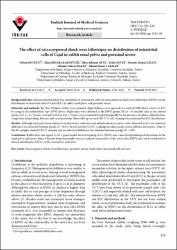| dc.contributor.author | Boybeyi, Ozlem | |
| dc.contributor.author | Fedakar Senyucel, Mine | |
| dc.contributor.author | Ayva, Ebru Sebnem | |
| dc.contributor.author | Soyer, Tutku | |
| dc.contributor.author | Aslan, Mustafa Kemal | |
| dc.contributor.author | Basar, Mehmet Murad | |
| dc.contributor.author | Cakmak, Ahmet Murat | |
| dc.date.accessioned | 2020-06-25T18:15:57Z | |
| dc.date.available | 2020-06-25T18:15:57Z | |
| dc.date.issued | 2015 | |
| dc.identifier.citation | Türer Ö. B., Fedakar M. Ş., Ayva E. Ş., Soyer T., Aslan M. K., Başar M. M., Çakmak A. M. (2015). The effect of extracorporeal shock wave lithotripsy on distribution of interstitial cells of Cajal in rabbit renal pelvis and proximal ureter. Turkish Journal of Medical Sciences, 45(1), 221 - 224. | en_US |
| dc.identifier.issn | 1300-0144 | |
| dc.identifier.issn | 1303-6165 | |
| dc.identifier.uri | https://doi.org/10.3906/sag-1312-38 | |
| dc.identifier.uri | https://hdl.handle.net/20.500.12587/6366 | |
| dc.description | Soyer, Tutku/0000-0003-1505-6042 | en_US |
| dc.description | WOS: 000347840000035 | en_US |
| dc.description | PubMed: 25790556 | en_US |
| dc.description.abstract | Background/aim: An experimental study was performed to evaluate the effect of extracorporeal shock wave lithotripsy (ESWL) on the distribution of interstitial cells of Cajal (ICC) in rabbit renal pelvis and proximal ureter. Materials and methods: Six New Zealand rabbits were included. Right kidneys were exposed to a total of 3000 shock waves (14 kV) by using an electrohydraulic-type ESWL device. Right sides were allocated as the ESWL group (EG, n = 6) and left sides as the control group (CG, n = 6). Tissues were harvested on day 7. Tissues were examined histopathologically for the presence of edema, inflammation, congestion, hemorrhage, fibrosis, and vascularization. Mast cell tryptase and CD117 (c-kit) staining was performed for ICC distribution. Results: Although increased tissue edema in renal pelvises and increased inflammation in ureters were observed in EG, no statistical difference was detected between groups (P > 0.05). In CG, positive CD117 staining was detected in 2 renal pelvises and ureters. None of the EG samples showed CD117 staining and no statistical difference was detected between groups (P > 0.05). Conclusion: Rabbit does not appear to be a good model for investigating ICCs. ESWL may cause histopathological alterations in the renal pelvis and ureter. Since it has not been statistically proven, reduced contractility of the ureter after ESWL may not be attributed to altered distribution of ICCs in the renal pelvis and ureter. | en_US |
| dc.description.sponsorship | Kirikkale University Scientific Research CouncilKirikkale University [2011/59] | en_US |
| dc.description.sponsorship | This study was supported by the Kirikkale University Scientific Research Council (2011/59). It was presented at the 24th Congress of the European Society of Pediatric Urology, Genoa, Italy, in 2013. | en_US |
| dc.language.iso | eng | en_US |
| dc.publisher | Tubitak Scientific & Technical Research Council Turkey | en_US |
| dc.relation.isversionof | 10.3906/sag-1312-38 | en_US |
| dc.rights | info:eu-repo/semantics/closedAccess | en_US |
| dc.subject | Extracorporeal shock wave lithotripsy | en_US |
| dc.subject | proximal ureter | en_US |
| dc.subject | renal pelvis | en_US |
| dc.subject | interstitial cells of Cajal | en_US |
| dc.title | The effect of extracorporeal shock wave lithotripsy on distribution of interstitial cells of Cajal in rabbit renal pelvis and proximal ureter | en_US |
| dc.type | article | en_US |
| dc.contributor.department | Kırıkkale Üniversitesi | en_US |
| dc.identifier.volume | 45 | en_US |
| dc.identifier.issue | 1 | en_US |
| dc.identifier.startpage | 221 | en_US |
| dc.identifier.endpage | 224 | en_US |
| dc.relation.journal | Turkish Journal Of Medical Sciences | en_US |
| dc.relation.publicationcategory | Makale - Uluslararası Hakemli Dergi - Kurum Öğretim Elemanı | en_US |
















